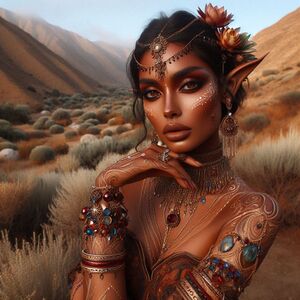Marakoua
Union of Marakoua Ohtarondo Marakouallo | |
|---|---|
Coat of arms
| |
| Motto: Wakwak Wakwak | |
| Anthem: Wakwak wakwak WakwakwakwakFile:Anthem.png | |
| File:Marakoua.Map.png Lands and territories of the Union of Marakoua | |
| Capital and largest city | Sassalagohan |
| Official languages | Marakouan |
| Ethnic groups | Lothlorin Elves (45.8%) Lethurin Elves (35.2%) Sorondil Elves (19%) |
| Religion | Wakwakism (100%) |
| Demonym(s) | Marakouan |
| Government | Union of tribal states |
• Tari Ardhon of Marakoua | Ka'lai Ruhamo |
| Legislature | Tsuatjitha of Marakoua |
| Establishment | |
• Foundation of the Union | ? |
| Area | |
• Total | [convert: invalid number] |
| Population | |
• Estimate | 48,000,000 |
| GDP (nominal) | estimate |
• Total | 3,360,000,000,000 |
• Per capita | 70,000 |
| Currency | Lulu (LUL) |
| Date format | dd/mm/yy |
| Driving side | left |
The Union of Marakoua or Marakoua [mɑːrækʊɑː] (Ohtarondo Marakouallo), is a tribal confederation composed of three distinct elven groups—the Sorondil, Lethúrin, and Lothlondir—inhabiting three distinct ecosystems within the Northeastern Never Realm. These tribes are bound by a common reverence for their living deity, Wakwak, a sentient tree god central to their spiritual and political life. The union is marked by its cultural diversity, with each tribe contributing unique traditions and practices to the collective identity of Marakoua.
Etymology
The name Marakoua derives from Marae Ko, the first elf to discover the power of Wakwak and - ua, meaning people or followers.
Geography
The territory of the Union of Marakoua encompasses three distinct regions, each home to one of the elven tribes:
- Sorondil: The cave-dwelling shrubland elves live atop plateaus, inhabiting a dry, rugged terrain where they have carved intricate cities into the cliffs and subterranean caverns. They are skilled in stonework, and their relationship with nature is deeply intertwined with the hardy, drought-resistant plants that grow in their arid surroundings.
- Lethúrin: The savanna elves roam the open plains, known for their nomadic lifestyle. They are expert animal herders and herbalists, moving in tandem with the changing seasons and resources of the savanna. Their open plains offer expansive skies, which play a significant role in their spiritual practices.
- Lothlondir: These swamp elves reside in the dark, tropical wetlands near the Sea of Immolation, where dense forests blend with marshlands. Known for their affinity with water and mud, the Lothlondir are skilled in camouflage, plant-based magic, and the use of poisons and medicines derived from their rich environment.
Religion
The Worship of Wakwak is central to the union’s culture and politics. Wakwak, the living tree god, physically resides in the heart of Marakoua. Wakwak’s unique ability to absorb the thoughts of reanimated heads—those of deceased elves, humans, other animals —and communicate by changing its leaf color is both revered and feared. Each leaf color represents different emotions, messages, or warnings, which guide the union’s decisions.
Culture
Though the tribes share a common faith, their lifestyles vary greatly, shaped by their environments:
- Sorondil culture emphasizes resilience, craftsmanship, and a deep connection to stone and earth. Their cities are architectural marvels, often hidden from the casual observer, and they are known for their ceremonial stone carvings and statues dedicated to Wakwak.
- Lethúrin culture is mobile and communal, centered around seasonal festivals and gatherings beneath sacred trees on the savanna. They are known for their rich oral traditions, songs, and dances, which celebrate the cycles of nature and the sky gods they believe protect Wakwak.
- Lothlondir culture is more secretive, with a strong emphasis on balance between life and death. They practice a form of swamp-based mysticism, and their knowledge of plant magic makes them powerful healers and dangerous foes in times of conflict. Their ceremonies are often conducted in silence, marked by offerings left in shadowed waters.
Politics
The Tari Ardhon, along with the elected High Chieftains of the triple alliance governs Marakoua, consisting of leaders from each of the three tribes, as well as a designated interpreter of Wakwak's messages, known as Tsuatjitha. Wakwak’s color-changing leaves serve as a form of divine communication, and no major decision is made without consulting the tree god.
Governance Structure
- The High Interpreters: These figures are trained from birth to read Wakwak’s messages. They interpret the changing colors of the tree’s leaves and act as spiritual guides for the entire union.
- The Tribal Chiefs: Each tribe elects a chief who represents them in the Tari Ardhon and High Chieftain council. The chiefs ensure that their tribe’s traditions and values are upheld while maintaining unity within the confederation.
The High Chieftain Council makes collective decisions regarding trade, defense, and conflict resolution, always seeking the wisdom of Wakwak before proceeding. Disputes between tribes are rare but are often resolved through ceremonies involving both negotiation and divine intervention from Wakwak.
Economy
The economy of Marakoua is primarily based on trade between the tribes, with each specializing in different goods:
- The Sorondil trade stoneworks, metals, and desert herbs.
- The Lethúrin are known for their herding animals, textiles, and medicinal plants found in the savanna.
- The Lothlondir offer rare swamp plants, potions, and healing remedies, often sought after by other elven tribes.
While the union is largely self-sufficient, external trade with other nations or elven societies is conducted cautiously, as the tribes believe in protecting the sanctity of Wakwak’s influence over their lands.

